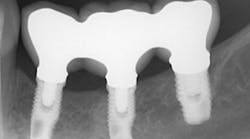In a previous article I went over the treatment planning process of Nancy’s two central incisors that had old restorations and the completion of the full crown preparations. This article is going to highlight the lab communication phase. In order to communicate efficiently and effectively with the lab on anterior restorations, I like to create a Keynote/Power Point presentation with text and images and save it as a PDF. In the file I include a set of initial photos of not just the teeth, but also the patient’s face and smile. I also include shade photos of the teeth we are trying to match and the underlying prep color, along with images of her smile with the temporaries.
In Nancy’s case, contour was extremely important in order to keep the characterization of her flared centrals that fit her face so well. The treatment plan was to restore both centrals with full crowns and improve their alignment, but not to make them too straight. Since I had gone to great lengths to prep the teeth correctly for that alignment, and made my temporaries with the desired alignment, an alginate impression was made of the temps and model poured to be sent to the laboratory as a guide to alignment and incisal edge position. A lower model is also included for occlusion.
Obviously one of the most important things to communicate to the lab–especially for two centrals–is shade. It is critical that the shade selection process is done at the beginning of the prep appointment so that the teeth have not dehydrated. Personally, I think photography communicates the desired shade, surface texture and surface luster better than anything else. Although some of the shade selection machines have advanced in quality over time, it’s really up to you as the clinician to evaluate if you do enough single or double anterior units to justify that expense for your practice. With Nancy’s case, I wanted the technician to see that a D3 tab was almost a perfect match to the middle of her centrals, with a D2 shade matching the incisal 1/3.
Along with the actual shade photos, I provide a description of my impression of the shade guides and how they relate to her teeth, describing that the middle of both centrals is a good match with the D3 tab, while the incisal 1/3 is a good match for D2, and the cervical 1/3 has slightly more chroma then the D3 tab, but is not as low in value or as high in chroma as a D4 tab.
The shade guide system you use should of course work with the materials and laboratory you work with. To ensure that the photos show the color of the teeth clearly I take them with the camera slightly above the tooth and shade guides and aim down, this prevents any highlights from the flash from blocking the view of the tooth or guide.
In addition, I take images of the just the teeth without the shade guides, with the camera lower and directly perpendicular to the teeth. These photos are taken from several angles, which produces highlights that reflect from the middle of the tooth and provides the technician an excellent view of the tooth surface texture and luster. After the prep a shade photograph is made to communicate prep color. Usually I take one photograph of the desired shade of the final restoration next to the prep, in this case D3, and another photo of the shade guide that is actually closest to the prep color.
In Part II, I’ll discuss the importance of alignment and material selection.
Reprinted with permission from Spear Education.







